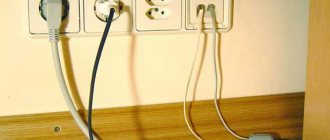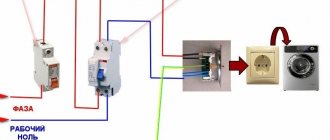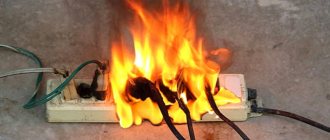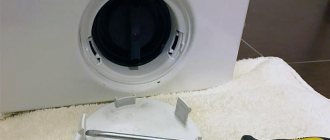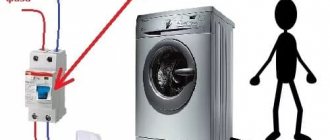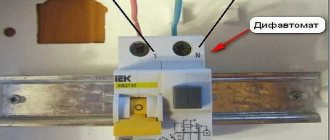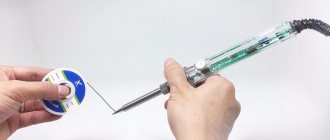Buying a high-quality and reliable washing assistant is only half the battle: to safely use new household appliances, you need to properly ground the washing machine. Many people call a technician from the nearest service center for this, but we suggest doing everything yourself. You need to adhere to a certain technique that will tell you step by step how to ground a washing machine, even if there is no grounding in the apartment.
Why ground a washing machine, what are the risks?
There is a stereotype in society that only old household appliances that have served for 5 years or more are dangerous. This is wrong. Machines that have recently been brought from the store and installed without following safety rules can cause electric shock.
At first, a slight tingling sensation is felt when touching the machine, and after a while (if nothing is done) a strong discharge occurs.
Electricians assure that all electrical appliances must be grounded. This applies to a greater extent to devices that are used in the bathroom due to high humidity levels. There are many outlets and appliances in this room, creating potential risks for residents.
Grounding is required for two reasons:
- If the equipment is not grounded, voltage may appear on the metal elements of the washing machine, and a person will be exposed to 110 Volts. Although small in size, this potential is enough to kill.
- Many models of washing machines that operate without grounding fail faster.
The presence of grounding guarantees safety for the user. If the insulation deteriorates and the wire in the supply circuit (inside the washing machine) breaks down, the voltage flows to the grounded circuit. As a result, a short-circuit current flows in the network and the circuit breaker at the input turns off the power.
If there is no grounding and a person comes into contact with voltage, the machine may not work. As a result, dangerous current flows through the body.
Useful tips and general recommendations
Before work, check the phase indicator on a conductor or terminal known to be connected to the current source. If there is little space in the distribution board, purchase a socket RCD.
The rated amperage of the residual current circuit breaker must be one step higher than that of the circuit breaker protecting it. If this condition is met, the device will be protected from operation in overload mode.
If the RCD is triggered falsely due to large leaks in the old wiring, instead of a 10 mA device, install a 30 mA analogue.
After connecting the wire to the terminal of the socket or distribution box, pull it to check that it is securely fastened.
In the bathroom, sockets with a dust and moisture protection class of at least IP44 are installed. The minimum height above the floor is 30 cm.
Grounding methods
Let's highlight the main options for grounding a washing machine in a bathroom or other room.
- Connecting the housing to sewerage, water supply or batteries.
- The output of a personal socket for which the ground wire is connected from the access panel.
- Creation of a system that equalizes the potential of equipment in the apartment.
- Switching on at the RCD input.
- Making your own ground loop. The last option is suitable for cases when a person lives in a private house.
Many people make the mistake and choose the first option. Theoretically, he is working, but his own salvation may result in the following consequences:
- In the event of a breakdown on the housing and poor grounding of the elements, the potential appears on the plumbing system or battery. As a result, people (residents of other apartments) who touch the metal part at this moment may be injured.
- This method of grounding accelerates the process of metal destruction. As a result, the pipe is damaged more quickly, and the risk of flooding your neighbors and your apartment is high.
In addition, PUE and PTE prohibit this method of grounding, so it should be abandoned.
The best way is to connect a separate outlet to which a grounded wire is connected from the driveway panel. This option is suitable for cases where the house has a grounding loop (some old multi-story buildings do not have one).
The difficulty is not to confuse the working zero and the ground. If you make a mistake and connect the wire to a phase, a short-circuit current will flow in the circuit. The result is the disconnection of the power supply at the entrance (for one phase). In addition, there is a high risk of getting burned.
Another way is to connect an additional wire to a metal grounded busbar, which is grounded and runs along all floors, and then “tightly” connect the wire to the body of the washing machine.
The downside of this option is that you will have to damage the integrity of the equipment casing, and the appearance of the household appliance will deteriorate.
Solving the potential equation involves performing the following actions. The housings of metal devices in an apartment (house) are connected to each other by current-carrying elements (wires). There is a uniform distribution of potential.
If a phase hits the ground, the potential will pass along the path of minimal resistance and will not go through the human body. There is nothing complicated in implementing the scheme, so it is easy to do it yourself.
If there is no grounding in a private house or apartment and a conductor with two cores is laid, you should choose an alternative option - install an RCD or a circuit breaker at the entrance to the apartment.
Causes of electric shocks
In the input circuits of the machine there is one double or two single capacitors - their purpose is to prevent interference from the engine and electronics from entering the network wiring. Similar filters are available in almost any technology.
The capacitors are connected according to a midpoint circuit - one from phase to body, the other from zero to body. Anyone who is at least a little familiar with electronics knows: if voltage is applied to two identical resistances connected in series, then at the midpoint a voltage of half the applied voltage will arise. And the two capacitors are resistances for alternating current (reactance). In other words, half of the supply voltage appears on the case - 110 V.
However, the internal resistance of such a midpoint is quite high (I call this “low load capacity”, in amateurish terms), a large current cannot arise from such a connection. In principle, a competent electrician understands all these things; I wrote this for complete “dummies” in electricity. Therefore, a person may not feel this tension on the body.
But in a humid room, any slight current is felt more strongly. And a lot can depend on surrounding factors - small currents can flow through a wet floor and then there will be no unpleasant “tingling” sensations. This effect does not always happen - apparently, the capacitance of the midpoint capacitors is strongly influenced here; in many devices it is purely symbolic and this does not cause problems.
Several facts can be stated unequivocally: 1. With proper grounding, nothing like this can happen in principle, but it doesn’t exist... 2. The current through the middle point is less than 10 mA, otherwise it would be impossible to connect the machine through an RCD. 3. It is impossible to remove the middle point of 2 capacitors from a machine under warranty.
In another case, problems arise due to “fatigue” of the equipment - when it has worked enough and is a little worn out. Excess moisture occurs inside the housing: flexible pipes wear out or, even worse, the tank leaks. If puddles do not form under the machine during washing, this is not yet an indicator of tightness. The pipes, for example, may splash only slightly at the highest speeds - no external leaks are observed.
Paired with worn wiring, humidity provokes various current leaks. By the way, often due to a leaky pipe, the electronics begin to malfunction - the equipment does not complete the entire cycle of the washing program or washes for an inappropriately long time. Apparently, the “brains” themselves are unlikely to be wet, but the sensors may well have wet contact with the body, thereby sending false signals to the control processor.
In general, no matter how you twist it or how much you argue, the problem requires an adequate solution - installation of grounding and current leakage protection (RCD). But if there were grounding, no questions would arise: the capacitors in the power supply would not cause any shocks, and a fault inside the machine would simply prevent the RCD from turning on normally. And if the RCD was constantly tripping, the device would be taken to a service center or they would try to fix it themselves.
Grounding conductor color
In order to ground a washing machine without errors, it is worth knowing the requirements for the colors of grounding conductors. On sale you can find wires of various options, which are made for convenience and safety.
When arranging wiring, as a rule, the following wires are used:
- Red - phase;
- Blue - “zero”;
- Yellow-green - “earth”.
In practice, colorless or white conductors are used. In the latter case, the ground wire is located in the central part.
With this approach it is difficult to make a mistake, because when connecting you need to connect the wires taking into account the color - red to red, blue to blue. As for the yellow-green “ground” wire, it needs to be “planted” on the ground terminal.
Errors during installation
If you mistakenly change the polarity, for example, by simply reversing the cables, on the casing of the washing machine, a phase potential may arise that is dangerous to others. Touching the machine and contact with grounded communications can lead to dire consequences.
For ease of installation, the color of the wires is made in different colors: the neutral wire is blue, the phase wire is brown-red, and the ground wire is yellow-green.
The wires must be twisted strictly in pairs using the diagram.
Another common mistake is connecting to unsuitable grounding conductors. Connections to water, sewer or heating pipes do not provide full contact with earth potential. The neighbors below may not have metal structures. The chain will be broken. Or an emergency situation may arise within the electrical network.
Grounding the washing machine in the apartment
The method of connecting a washing machine in an apartment in a multi-storey building depends on the year the building was built. If the house was built recently and belongs to the category of new buildings, finding a grounded busbar in the panel will not be a problem.
Moreover, many houses are built taking into account each apartment, and the wires are laid with three cores.
Household appliances (washing machine, microwave oven and other equipment) have a wire with three cores, so safety is guaranteed.
If the building was erected before 1990, it is worth carefully examining the panel for the presence of a grounding busbar.
There are two ways to ground a washing machine: do the work yourself or use the services of an electrician.
When connecting independently, the algorithm of actions is as follows:
- Install two buses in the panel - neutral and grounding. Wires will be connected to them, which will go into the apartment to lighting devices and household appliances.
- Stretch a cable with three copper cores with a cross-section of 2.5 square meters from the access panel to the washing machine. mm. The wire connection is as follows. First, the blue wire (“zero”) is connected to the N scale, and then the red wire (phase) passes through the circuit breaker, RCD and is sent to the electricity meter. The “ground” (blue-yellow conductor) must be connected to the ground bus. It is prohibited to combine grounding and working zero.
Next, all that remains is to install the outlet and connect it. This requires a socket, an indicator screwdriver, pliers, a cable with three cores, a knife and a socket with a grounding terminal. If the considered set of works seems complicated, you should entrust the work to a master.
READ MORE: How to install an outlet in the bathroom.
How to do it right?
In principle, making grounding in an apartment for a washing machine is not so difficult. This work can be done independently. But there is one tricky point.
Before upgrading the wiring, you must write an application to your own management company, demanding that “land” be brought into the apartment.
The Criminal Code will most likely refuse in this matter. But a signed waiver or at least a copy of such a statement will be excellent insurance. In the event of problems with the wiring that cause damage to household appliances, you can safely go to court with this document. The management company will be required to reimburse the cost of damaged equipment. Because she did not fulfill her direct responsibilities.
You can, of course, do without paperwork and draw the “ground” from the shield yourself. But in this case you should not hope for compensation. The management company will definitely find inconsistencies with GOSTs and SNIPs in the “homemade” wiring and will reasonably refuse to pay.
In a private house
Connecting the grounding of a washing machine in a private house differs little from the algorithm discussed above. The ground wire is also led from the main panel.
The difference is that there is no grounding at the entrance, and you will have to do it yourself. Previously, the installation process was briefly discussed, but here are detailed instructions:
- Find three metal pipes ranging from one and a half to three meters in length. When choosing the length, keep in mind that it should not be less than the depth to which the ground freezes in winter.
- Use a sledgehammer to make a point at the bottom of the pipe and drill 0.5-1 cm holes here.
- Dig a hole to a depth of 50-60 cm, then drive the pipes into the ground at a distance of one to one and a half meters. 100-150 mm of pipe should remain above the surface.
- Find three metal plates (you can use reinforcement) 100-150 cm long, then weld them to the edges of the pipes located above the surface.
- Weld a ground wire to the fittings, which will go to the meter installation site. The installation method is selected taking into account local conditions.
- Connect the grounding wire to the PE bus, and then branch the grounding wires to lighting and sockets.
For reliability, the grounding wire is attached with a bolt to the back of the machine (such a bolt is already provided by the manufacturer).

